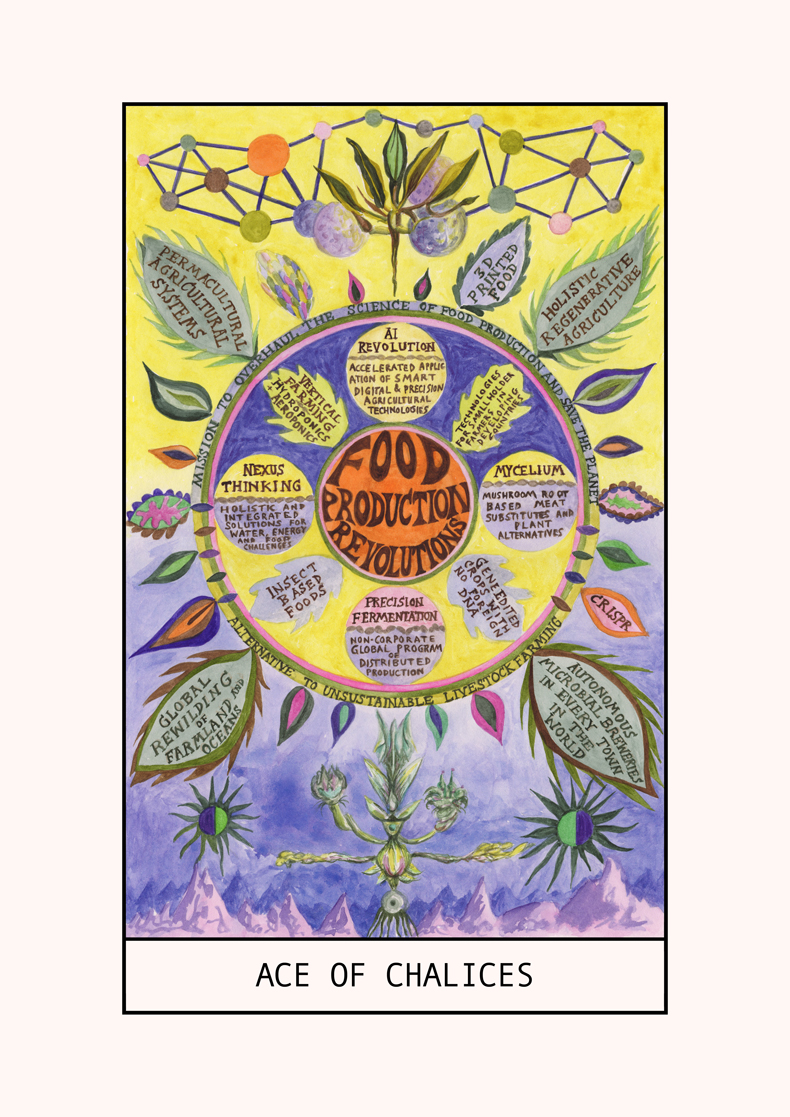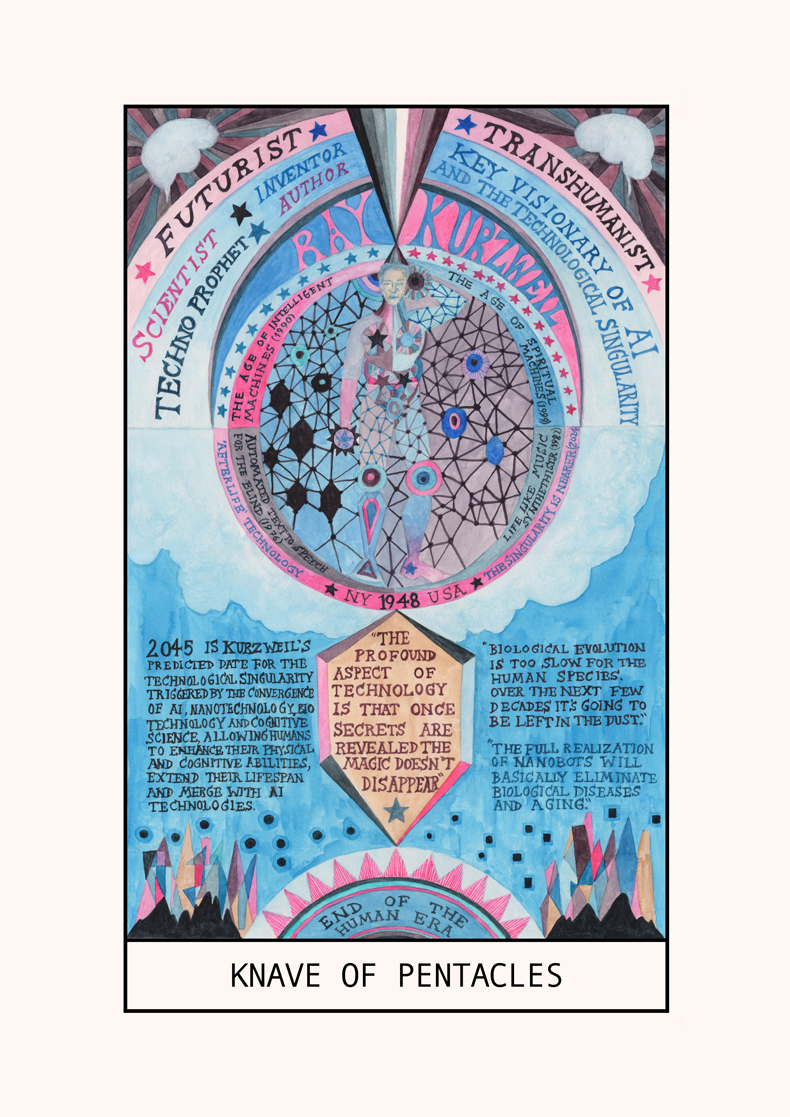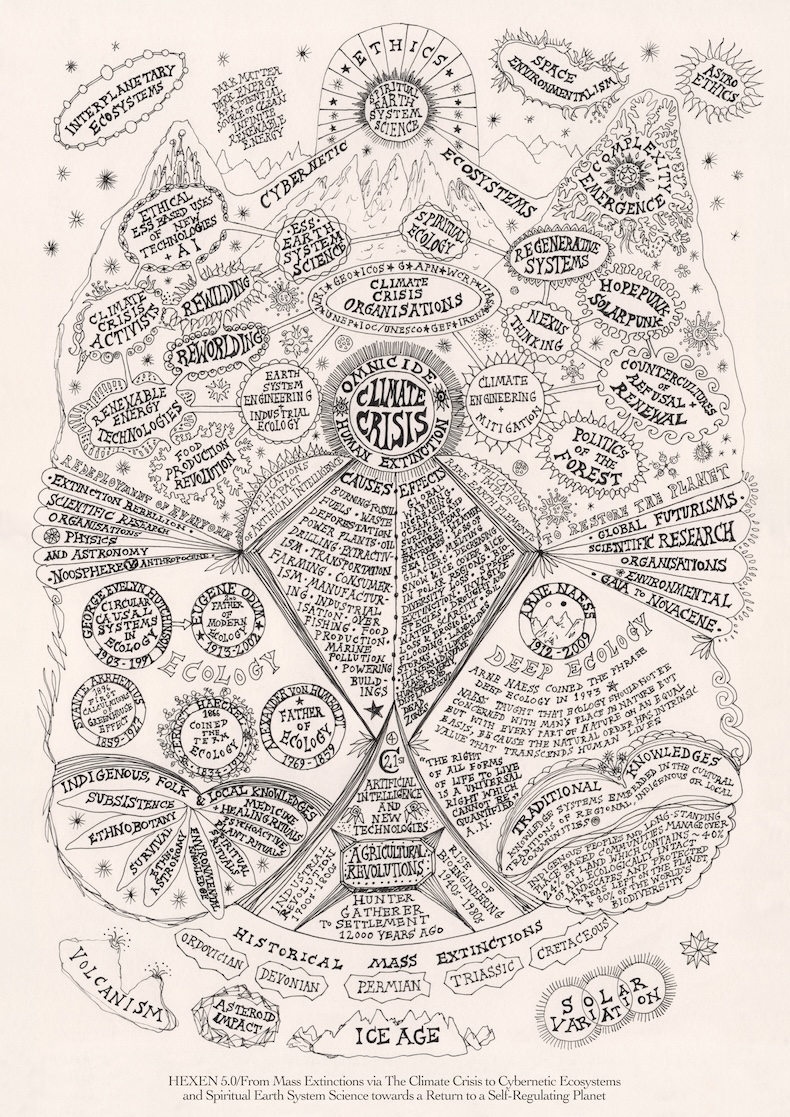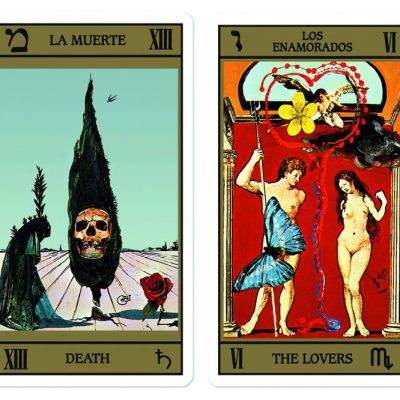It’s very hard to talk about Suzanne Treister’s Hexen 2.0 without sounding like a crank. That might be inevitable, so I might as well embrace it. Hexen 2.0 isn’t simply adjacent to conspiracy theories, arcane knowledge and secret histories, it’s in whirling union with them. Adding to the crank-y vibe is the knowing resemblance to the crowded canvases and arcane private languages of outsider art. And Treister’s work has a tendency to make wild-eyed converts out of people. I write these words under a print from Hexen 2.0, which hangs above my desk and is a little hard to describe succinctly. It’s a sort of occult schematic with figures from science, technology and counterculture – such as Tim Berners-Lee and Stewart Brand – arranged in a pentacle and orbited by a concentric system of scrawled text relating the history of the internet and the military-industrial complex, in a constellation of intelligence agencies.
The print I sit under is one of the ‘historical diagrams’ that form a key to Hexen 2.0, but at the heart of the project is a tarot deck. Each of the 78 cards in this deck represents an individual, organisation, text or concept from the history of computing, technological speculation, the military-industrial complex, or the counterculture. These reach back to Diogenes of Sinope and the 12th-century mechanical clock of al-Jazari, but mostly focus on post-war American society. A connecting thread is the ‘Macy conferences’ conducted in New York between 1942 and 1960, which aimed to foster interdisciplinary communication in the sciences, and which laid the groundwork for what is now called ‘cybernetics’. But ‘The Devil’ in the deck, literally and metaphorically, is ‘the control society’: modern, subtle panoptic totalitarianism, enabled by information technology, governed by an unaccountable web of private and public bodies.
Hexen 5.0 (Ace of Chalices) (2023–25), Suzanne Treister. Courtesy Annely Juda Fine Art; © the artist

In a traditional tarot deck, The Devil is one of the ‘major arcana’, the 22 unique named cards which most people think of when they think of tarot: The Sun, The Moon, The Hanged Man, and so on. In Hexen 2.0, The Wheel of Fortune is cybernetics, defined as ‘the science of control and communication in the animal and the machine’ by American mathematician and Macy attendee Norbert Wiener. Wiener himself is The Chariot. Death, the most renowned and ominous of the major arcana, is represented by John von Neumann, one of the fathers of the atomic bomb and one of the more brilliant minds to dedicate themselves to the military-industrial complex. Also represented are dissidents and enemies of industrial society, such as Timothy Leary (The Fool) and Theodore Kaczynski, aka the Unabomber (The Hermit, naturally). So it goes for the whole 78-card deck, with each illustrated in Treister’s compelling, feverish style.
It’s the interactive quality of the deck that gives it its power. Drawing a hand – the basic tarot draw is three cards, but can go up to ten – is like taking a cross section through recent history, revealing hidden conduits and currents; or it can seem to point to a future, either desirable or undesirable. I have the deck to hand, and a sample draw for the purposes of this piece produced: Gerrard Winstanley, leader of the Diggers, a communitarian radical movement during the English Civil War; MKULTRA, the CIA’s infamous mind-control experiments; and ‘dream-sharing’, a hypothetical technology of ‘network-enabled telepathy’.
Hexen 5.0 (Knave of Pentacles) (2023–25), Suzanne Treister. Courtesy Annely Juda Fine Art; © the artist

What is the connection? Even the non sequiturs stimulate the imagination. That, of course, is the beauty of it: Treister simply provides the push-pins, the reader provides the red wool to join them up. Treister is also largely non-judgemental in her approach, which helps make the speculations generated by Hexen 2.0 all the more open-ended. The technologies and systems are not in themselves good or bad, the real trouble is in the relationships and feedback loops. The scenarios revealed in each hand might suggest the past or the future, or utopia or dystopia – it is left to the reader. It’s unusual for an artwork to make such a stimulating activity, essentially a game – it really can fill hours.
Since its publication in 2012, Hexen 2.0 has felt increasingly important, as ‘the online’ has saturated civil society, routine electronic surveillance has advanced and Silicon Valley has entered its imperial phase. Most valuable, I think, is its capacity to hint at alternatives to the rather bleak looming shadow of the military-industrial ‘control society’, through its heavy inclusion of emancipatory, open-source, or countercultural concepts. Hexen 2.0 isn’t a manifesto but a toolbox that permits the reader to create their own.
HEXEN 5.0/Historical Diagrams/From Mass Extinctions via The Climate Crisis to Cybernetic Ecosystems and Spiritual Earth System Science towards a Return to a Self-Regulating Planet (2023–25), Suzanne Treister. Courtesy Annely Juda Fine Art; © the artist

Treister has this year released Hexen 5.0, an all-new deck for the 2020s, presently being exhibited at Annely Juda Fine Art in London ahead of a solo show at MOMA in Oxford in the autumn. Influencers, rare earth elements, cryptocurrency and Extinction Rebellion are among the new cards, pointing to the ways the world has changed since 2012, but the update only shows the continuing relevance of the earlier version. The emphasis has changed – less on hardware and more on software – and more about the future than the past: Post-Truth has replaced Cybernetics as the Wheel of Fortune card; Climate Change has replaced Death. Treister’s art style has become a little more lush and deep, losing some of the urgent penpoint scratchiness of 2.0 but without sacrificing its outsiderish charm. In addition to the new deck there is a new set of ‘diagrams’; these include a series generated by AI. This latter development might dismay many, and the works are the standard glittery-glossy false-detail sausage meat we have come to expect from Silicon Valley’s planet-boiling toy. But it feels easily forgivable coming from Treister, whose work does so much to expose the innards of the black box of technological society.
‘HEXEN 5.0 and Museum Paintings’ is at Annely Juda Fine Art, London, until 3 May.



